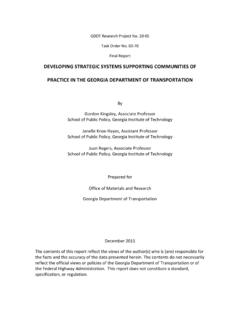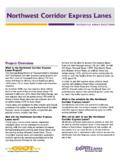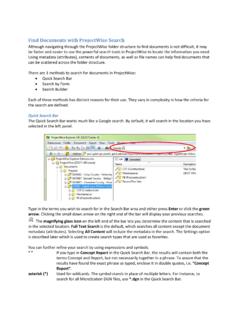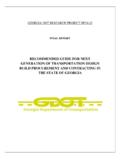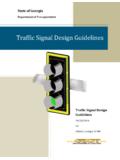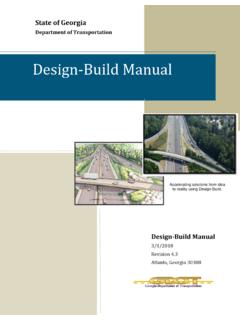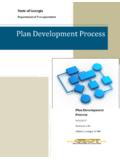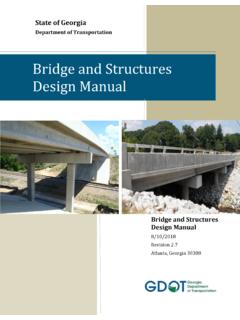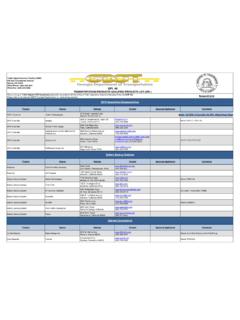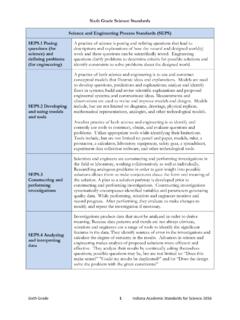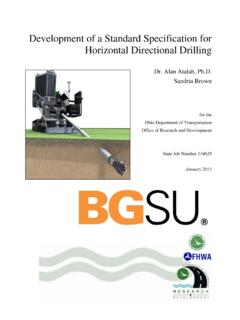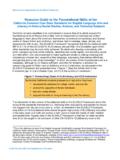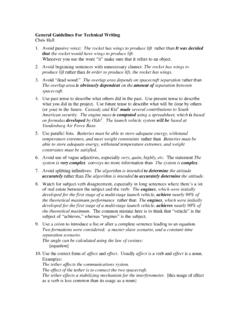Transcription of BEST PRACTICES IN SELECTING PERFORMANCE MEASURES …
1 GEORGIA DOT research project 09-03 FINAL REPORT BEST PRACTICES IN SELECTING PERFORMANCE MEASURES AND standards FOR EFFECTIVE ASSET MANAGEMENT OFFICE OF MATERIALS AND research research AND DEVELOPMENT BRANCH Best PRACTICES in SELECTING PERFORMANCE MEASURES and standards for Effective Asset Management FINAL REPORT 2 TECHNICAL REPORT STANDARD TITLE PAGE No.: FHWA-GA-11-0903 2. Government Accession No.: 3. Recipient's Catalog No.: 4. Title and Subtitle: Best PRACTICES in SELECTING PERFORMANCE MEASURES and standards for Effective Asset Management 5. Report Date: June 2011 6. Performing Organization Code: 7. Author(s): Adjo Amekudzi, Michael Meyer, , 8.
2 Performing Organ. Report No.: 09-03 9. Performing Organization Name and Address: Georgia Tech research Corporation Georgia Institute of Technology School of Civil and Environmental Engineering Atlanta, GA 30332-0355 10. Work Unit No.: 11. Contract or Grant No.: SPR00-0008-00-467 12. Sponsoring Agency Name and Address: Georgia Department of Transportation Office of Materials & research 15 Kennedy Drive Forest Park, GA 30297-2534 13. Type of Report and Period Covered: Final; January 2009 June 2011 14. Sponsoring Agency Code: 15. Supplementary Notes: Prepared in cooperation with the Department of Transportation, Federal Highway Administration.
3 16. Abstract: This report assesses and provides guidance on best PRACTICES in PERFORMANCE measurement, management and standards setting for effective Transportation Asset Management (TAM). The study is conducted through a literature review, a survey of the 50 state DOTs, an internal assessment of Georgia Department of Transportation s TAM capabilities and PERFORMANCE measurement and management procedures, and a review of risk applications in TAM with a case study demonstrating the impacts of uncertainty on project prioritization. The study isolates three generations of agencies as far as PERFORMANCE management is concerned. The study recommends conducting a review of GDOT s PERFORMANCE measurement and management process and procedures using current standards ; benchmarking against similar and more mature state agencies; developing metrics for evaluating progress toward strategic goals; linking PERFORMANCE metrics with resource allocation decisions; developing analytical and data capabilities for evaluating tradeoffs in resource allocation decision making; refining MEASURES for use in broad agency functions; refining PERFORMANCE communication tools.
4 Addressing uncertainties in PERFORMANCE metrics and management in TAM, and upgrading existing PERFORMANCE procedures and capabilities to meet state audit requirements. 17. Key Words: PERFORMANCE MEASURES , PERFORMANCE Management, Transportation Asset Management, Risk 18. Distribution Statement: 19. Security Classification (of this report): Unclassified 20. Security Classification (of this page): Unclassified 21. Number of Pages: 37 22. Price: Form DOT (8-69) Best PRACTICES in SELECTING PERFORMANCE MEASURES and standards for Effective Asset Management FINAL REPORT 3 Best PRACTICES in SELECTING PERFORMANCE MEASURES and standards for Effective Asset Management FINAL REPORT Submitted to: Georgia Department of Transportation Angela Alexander, Submitted by: Georgia Institute of Technology Adjo Amekudzi, , Michael Meyer, , , July 2011 Best PRACTICES in SELECTING PERFORMANCE MEASURES and standards for Effective Asset Management FINAL REPORT 4 TABLE OF CONTENTS Contents Page Numbers List of Tables and Figures 4 Executive Summary 5 1.
5 Objectives 7 2. Methodology 10 3. Key Messages and Findings Guidelines for SELECTING PERFORMANCE MEASURES and Targets Best PRACTICES : PERFORMANCE Measurement in State DOTs Evolution of Asset Management at GDOT Transportation Asset Management (TAM) Internal Review TAM Peer Exchange Development of TAM Program Inventory of TAM Tools and Data 10 10 16 16 17 17 17 18 4. Uncertainty and Risk in TAM Risk and TAM Uncertainty and Risk Risk Assessment and Risk Management Risk Attitudes Risk Applications in TAM Risks Identification for Coastal Roadways Risk Matrix for Projects Risk Analysis for Bridge Prioritization Risk Analysis for Asset Prioritization Risk Analysis for Bridge Prioritization and Inspections Applying Multiple Attribute Decision Making (MADM) Methodology to Prioritize Georgia Bridges 20 20 20 21 22 22 22 23 23 24 26 27 5.
6 The PERFORMANCE Resource Catalogue 29 6. Developing a Pipeline of Transportation Professionals 30 7. Conclusions and Recommendations 31 References 34 Appendices Appendix 1: Literature Review Synthesis Appendix 2: PERFORMANCE Measurement in State DOTs Appendix 3: PERFORMANCE Survey of State DOTs Appendix 4: GDOT Inventory of TAM Tools Appendix 5(a): Update to the Domestic TAM Scan Appendix 5(b): GDOT/UDOT/Indiana DOT TAM Peer Exchange Report Appendix 6: Effects of PERFORMANCE Uncertainty on TAM Appendix 7: A Resource Catalogue for Transportation PERFORMANCE Management Best PRACTICES in SELECTING PERFORMANCE MEASURES and standards for Effective Asset Management FINAL REPORT 5 LIST OF TABLES AND FIGURES TABLES TABLE 1: Generational Model of PERFORMANCE Management TABLE 2.
7 Summary of GDOT TAM Tools and Data TABLE 3: Values for Calculating Likelihood of Risk Events (England DfT) TABLE 4: Sample Risk Severity Zones (Edmonton, Canada) TABLE 5: GDOT Bridge Prioritization Formula -- Parameter Descriptions/Values FIGURES FIGURE 1: Overview of Transportation Asset Management FIGURE 2: Transportation Asset Management: Resource Allocation and Utilization FIGURE 3: Information Reporting Hierarchy at VicRoads, Victoria, Australia FIGURE 4: Risk Severity vs. Replacement Value Chart Edmonton, Canada FIGURE 5: Highway Bridge Risk Universe Best PRACTICES in SELECTING PERFORMANCE MEASURES and standards for Effective Asset Management FINAL REPORT 6 EXECUTIVE SUMMARY This report reports the results of a study that assesses and provides guidance on PERFORMANCE MEASURES and standards for effective Transportation Asset Management (TAM).
8 PERFORMANCE MEASURES are defined as indicators of system effectiveness and efficiency. Asset Management is the combination of management, financial, economic, engineering and other PRACTICES applied to physical assets with the objective of providing the required level of service in the most cost effective manner. Thus, PERFORMANCE measurement and management are critical components of an effective TAM system. TAM and PERFORMANCE management are both evolving PRACTICES , meaning that applications and best PRACTICES in these fields continue to expand and improve systematically over time. The study was conducted through a literature review, a survey of the 50 states for current and best PRACTICES in PERFORMANCE measurement and management in TAM, an internal review of GDOT s present TAM capabilities and PERFORMANCE measurement and management procedures; and a review of risk applications in TAM followed by a case study demonstrating how uncertainty can be incorporated in project prioritization to enhance prioritization outcomes.
9 The study findings show that PERFORMANCE measurement alone is incomplete for effective TAM but, in addition, PERFORMANCE metrics must be applied in resource allocation decision making to manage agencies toward achieving their strategic goals consistently. Agencies with effective TAMs will have fewer, clearer strategic goals that are linked with PERFORMANCE MEASURES (including outcome MEASURES ) for which metrics are developed and utilized in resource allocation decisions. As PERFORMANCE management is an evolving practice, various agencies are at different levels in measuring and managing PERFORMANCE . First-Generation or Traditional agencies (with large number of MEASURES , not strategically aligned), Second-Generation or Hierarchy of Measurement agencies (with many MEASURES tracking system PERFORMANCE and organizational process improvement for their specific program and project decision-making purposes; but not usually linked meaningfully to other agency processes) and Third-Generation or Catalyst-Driven agencies ( that use lessons learned to refine PRACTICES and have developed the flexibility to retool and adapt an established system in response to changing agency priorities and external pressures).
10 Communicating PERFORMANCE effectively to external stakeholders ( , the general public, the legislature and media) is critical. Effective PERFORMANCE communication within the agency is also critical for achieving strategic objectives. The Georgia Department of Transportation (GDOT) has developed four strategic goals and is in the process of developing PERFORMANCE MEASURES to evaluate and manage progress toward strategic objectives. GDOT has multiple infrastructure management tools (such as pavement management, bridge information management, and maintenance management, etc.) with supporting data that will be helpful for generating PERFORMANCE metrics. The study recommends the following: (i) PERFORMANCE benchmarking against other state DOTs; (ii) developing metrics to evaluate progress toward strategic objectives; (iii) linking PERFORMANCE metrics with resource allocation decision making and developing data and analytical capabilities for evaluating tradeoffs; (iv) refining metrics for use in broader agency functions ( , planning and management, operations and design/management); (v) refining PERFORMANCE reports to be more effective communication tools; (v) addressing uncertainties in PERFORMANCE management to improve the quality of PERFORMANCE outcomes data.
